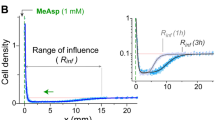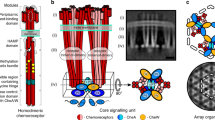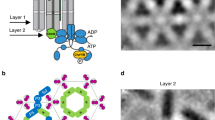Abstract
The sensing mechanisms of chemotactic bacteria allow them to respond sensitively to stimuli. Escherichia coli, for example, respond to changes in chemoattractant concentration of less than 10% over a range spanning six orders of magnitude1,2. Sensitivity over this range depends on a nonlinear relationship between ligand concentration and output response3. At low ligand concentrations, substantial amplification of the chemotactic signal is required; however, the mechanism responsible for this amplification remains unclear. Here we demonstrate that inter-receptor communication within a lattice4,5 acts to amplify and integrate sensory information. Synthetic multivalent ligands that interact through the low-abundance, galactose-sensing receptor Trg stabilize large clusters of chemoreceptors and markedly enhance signal output from these enforced clusters. On treatment with multivalent ligands, the response to the attractant serine is amplified by at least 100-fold. This amplification requires a full complement of chemoreceptors; deletion of the aspartate (Tar) or dipeptide (Tap) receptors diminishes the amplification of the serine response. These results demonstrate that the entire array is involved in sensing. This mode of information exchange has general implications for the processing of signals by cellular receptors.
This is a preview of subscription content, access via your institution
Access options
Subscribe to this journal
Receive 51 print issues and online access
$199.00 per year
only $3.90 per issue
Buy this article
- Purchase on Springer Link
- Instant access to full article PDF
Prices may be subject to local taxes which are calculated during checkout




Similar content being viewed by others
References
Mesibov, R., Ordal, G. W. & Adler, J. The range of attractant concentrations for bacterial chemotaxis and the threshold and size over this range. J. Gen. Physiol. 62, 203–223 (1973).
Adler, J., Hazelbauer, G. L. & Dahl, M. M. Chemotaxis towards sugars in Escherichia coli. J. Bacteriol. 115, 824–847 (1973).
Jasuja, R., Yu-Lin,, Trentham, D. R. & Khan, S. Response tuning in bacterial chemotaxis. Proc. Natl Acad. Sci. USA 96, 11346–11351 (1999).
Duke, T. A. J. & Bray, D. Heightened sensitivity of a lattice of membrane receptors. Proc. Natl Acad. Sci. USA 96, 10104–10108 (1999).
Bray, D., Levin, M. D. & Morton-Firth, C. J. Receptor clustering as a cellular mechanism to control sensitivity. Nature 393, 85–88 (1998).
Bren, A. & Eisenbach, M. How signals are heard during bacterial chemotaxis: Protein–protein interactions in sensory signal perception. J. Bacteriol. 182, 6865–6873 (2000).
Barkai, N. & Leibler, S. Robustness in simple biochemical networks. Nature 387, 913–917 (1997).
Hazelbauer, G. L. & Engström, P. Multiple forms of methyl-accepting chemotaxis proteins distinguished by a factor in addition to multiple methylation. J. Bacteriol. 145, 35–42 (1981).
Slocum, M. K. & Parkinson, J. S. Genetics of methyl-accepting chemotaxis proteins in Escherichia coli: organization of the tar region. J. Bacteriol. 155, 565–577 (1983).
Gegner, J. A., Graham, D. R., Roth, A. F. & Dahlquist, F. W. Assembly of an MCP receptor, CheW, and kinase CheA complex in the bacterial chemotaxis signal transduction pathway. Cell 70, 975–982 (1992).
Liu, Y., Levit, M., Lurz, R., Surette, M. G. & Stock, J. B. Receptor-mediated protein kinase activation and the mechanism of transmembrane signaling in bacterial chemotaxis. EMBO J. 16, 7231–7240 (1997).
Schuster, S. C., Swanson, R. V., Alex, L. A., Bourret, R. B. & Simon, M. I. Assembly and function of a quaternary signal transduction complex by surface plasmon resonance. Nature 365, 343–347 (1993).
Ottemann, K. M., Xiao, W., Shin, Y.-K. & Koshland, D. E. Jr A piston model for transmembrane signaling of the aspartate receptor. Science 285, 1751–1754 (1999).
Maddock, J. R. & Shapiro, L. Polar location of the chemoreceptor complex in the Escherichia coli cell. Science 259, 1717–1723 (1993).
Gestwicki, J. E. et al. Evolutionary conservation of methyl-accepting chemotaxis protein location in Bacteria and Archaea. J. Bacteriol. 182, 6499–6502 (2000).
Barnakov, A. N., Barnakov, L. A. & Hazelbauer, G. L. Comparison in vitro of a high- and a low-abundance chemoreceptor of Escherichia coli: similar kinase activation but different methyl-accepting activities. J. Bacteriol. 180, 6713–6718 (1998).
Li, J., Li, G. & Weis, R. M. The serine chemoreceptor from Escherichia coli is methylated through an inter-dimer process. Biochemistry 36, 11851–11857 (1997).
Gardina, P. J. & Manson, M. D. Attractant signaling by an aspartate chemoreceptor dimer with a single cytoplasmic domain. Science 274, 425–426 (1996).
Tatsuno, I., Homma, M., Oosawa, K. & Kawagishi, I. Signaling by the Escherichia coli aspartate chemoreceptor Tar with a single cytoplasmic domain per dimer. Science 274, 423–425 (1996).
Yeh, J. I., Biemann, H.-P., Pandit, J., Koshland, D. E. & Kim, S.-H. The three-dimensional structure of the ligand-binding domain of a wild-type chemotaxis receptor. J. Biol. Chem. 268, 9787–9792 (1993).
Trnka, T. M. & Grubbs, R. H. The development of L2X2Ru = CHR olefin metathesis catalysts: an organometallic success story. Acc. Chem. Res. 34, 18–29 (2001).
Gestwicki, J. E., Strong, L. E. & Kiessling, L. L. Tuning chemotactic responses using synthetic multivalent ligands. Chem. Biol. 7, 583–591 (2000).
Gestwicki, J. E. et al. Designed potent multivalent chemoattractants for Escherichia coli. Bioorg. Med. Chem. 9, 2387–2393 (2001).
Sager, B. M., Sekelsky, J. J., Matsumura, P. & Adler, J. Use of a computer to assay motility in bacteria. Anal. Biochem. 173, 271–277 (1988).
Parkinson, J. S. & Houts, S. E. Isolation and behavior of Escherichia coli deletion mutants lacking chemotaxis functions. J. Bacteriol. 151, 106–113 (1982).
Hazelbauer, G. L., Mesibov, R. E. & Adler, J. Escherichia coli mutants defective in chemotaxis toward specific chemicals. Proc. Natl Acad. Sci. USA 64, 1300–1307 (1969).
Yin, C. C. & Lai, F. A. Intrinsic lattice formation by ryanodine receptor calcium-release channel. Nature Cell Biol. 2, 669–671 (2000).
Matsuuchi, L. & Gold, M. R. New views of BCR structure and organization. Curr. Opin. Immunol. 13, 270–277 (2001).
Delon, J. & Germain, R. N. Information transfer at the immunological synapse. Curr. Biol. 10, R923–R933 (2000).
Chan, C., George, A. J. T. & Stark, J. Cooperative enhancement of specificity in a lattice of T cell receptors. Proc. Natl Acad. Sci. USA 98, 5758–5763 (2001).
Acknowledgements
We thank J. Adler for supplying E. coli strains AW405, AW550, AW518 and AW701, and for advice. We thank J. S. Parkinson for E. coli strains RP1078, RP5854 and RP2361, and for anti-MCP antibodies. This work was supported by the National Institutes of Health (NIH). J.E.G. acknowledges the NIH Biotechnology Training Grant for support.
Author information
Authors and Affiliations
Corresponding author
Ethics declarations
Competing interests
The authors declare no competing financial interests.
Supplementary information
Rights and permissions
About this article
Cite this article
Gestwicki, J., Kiessling, L. Inter-receptor communication through arrays of bacterial chemoreceptors. Nature 415, 81–84 (2002). https://doi.org/10.1038/415081a
Received:
Accepted:
Issue Date:
DOI: https://doi.org/10.1038/415081a
This article is cited by
-
Advances in emerging hydrogel fouling-release coatings for marine applications
Journal of Coatings Technology and Research (2024)
-
Glycopolymer-Based Materials: Synthesis, Properties, and Biosensing Applications
Topics in Current Chemistry (2022)
-
Critical parameters for design and development of multivalent nanoconstructs: recent trends
Drug Delivery and Translational Research (2022)
-
Bacterial chemoreceptors and chemoeffectors
Cellular and Molecular Life Sciences (2015)
-
Bacteria-instructed synthesis of polymers for self-selective microbial binding and labelling
Nature Materials (2014)
Comments
By submitting a comment you agree to abide by our Terms and Community Guidelines. If you find something abusive or that does not comply with our terms or guidelines please flag it as inappropriate.



